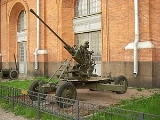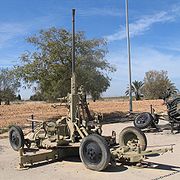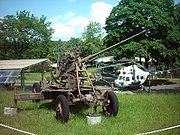
M1939 37 mm anti-aircraft gun
Encyclopedia

World War II
World War II, or the Second World War , was a global conflict lasting from 1939 to 1945, involving most of the world's nations—including all of the great powers—eventually forming two opposing military alliances: the Allies and the Axis...
. The land based version was replaced in Soviet service by the ZSU-57-2
ZSU-57-2
The ZSU-57-2 is a Soviet self-propelled anti-aircraft gun , armed with two 57 mm autocannons. 'ZSU' stands for Zenitnaya Samokhodnaya Ustanovka , meaning "anti-aircraft self-propelled mount", '57' stands for the bore of the armament in millimetres and '2' stands for the number of gun barrels....
during the 1950s. Guns of this type were successfully used throughout the Eastern Front
Eastern Front (World War II)
The Eastern Front of World War II was a theatre of World War II between the European Axis powers and co-belligerent Finland against the Soviet Union, Poland, and some other Allies which encompassed Northern, Southern and Eastern Europe from 22 June 1941 to 9 May 1945...
against dive bombers and other low- and medium-altitude targets. It also had some usefulness against lightly armored ground targets. Crews of the 37 mm AD guns shot down 14,657 Axis planes. The mean quantity of 37 mm ammunition to shoot down one enemy plane was 905 rounds.
Development
The Soviet Navy purchased a number of BoforsBofors
The name Bofors has been associated with the iron industry for more than 350 years.Located in Karlskoga, Sweden, the company originates from the hammer mill "Boofors" founded 1646. The modern corporate structure was created in 1873 with the foundation of Aktiebolaget Bofors-Gullspång...
25 mm Model 1933 guns in 1935, trials of the weapon were successful and it was decided to develop a 45 mm version of the weapon designated the 49-K. The development under the guidance of leading Soviet designers M. N. Loginov, I. A. Lyamin and L. V. Lyuliev was successful, but the army thought that the 45 mm calibre was a little too large for an automatic field weapon. In January 1938 Artillery Factory Number 8 in Kaliningrad
Kaliningrad
Kaliningrad is a seaport and the administrative center of Kaliningrad Oblast, the Russian exclave between Poland and Lithuania on the Baltic Sea...
was ordered to develop a 37 mm weapon based on the same design. The task was fulfilled by the chief designer of the Factory Mikhail Loginov
Mikhail Loginov
Mikhail Nikolayevich Loginov – October 28, 1940, Miskhor, Crimean ASSR) was a prominent Soviet designer of anti-tank, air-defense, and other types of artillery, widely used during World War II....
and his assistant Lev Loktev. Firing trials of the new 61-K were conducted in October 1938.
Competitive firing trials were conducted in 1940 between the 61-K and the Bofors 40 mm/56
Bofors 40 mm gun
The Bofors 40 mm gun is an anti-aircraft autocannon designed by the Swedish defence firm of Bofors Defence...
. They found that there were no substantial differences between them.

Land version
The weapon was initially installed as a single barrel weapon on a four wheeled ZU-7 carriage, and was soon ready for service. An initial order for 900 units was placed. The gun was operated by a crew of eight men. A total of 200 rounds of ammunition were carried which were fed into the gun in five round clips. Total Soviet production was around 20,000 units, ending in 1945. However, it has also been produced in PolandPoland
Poland , officially the Republic of Poland , is a country in Central Europe bordered by Germany to the west; the Czech Republic and Slovakia to the south; Ukraine, Belarus and Lithuania to the east; and the Baltic Sea and Kaliningrad Oblast, a Russian exclave, to the north...
, China
China
Chinese civilization may refer to:* China for more general discussion of the country.* Chinese culture* Greater China, the transnational community of ethnic Chinese.* History of China* Sinosphere, the area historically affected by Chinese culture...
and North Korea
North Korea
The Democratic People’s Republic of Korea , , is a country in East Asia, occupying the northern half of the Korean Peninsula. Its capital and largest city is Pyongyang. The Korean Demilitarized Zone serves as the buffer zone between North Korea and South Korea...
.
Armour penetration of the armour-piercing (AP) rounds is reported as 37 millimeters of Rolled homogeneous armour
Rolled homogeneous armour
Rolled homogeneous armour is a type of steel which is used to armour vehicles.-Composition:Armoured steel must be hard yet impervious to shock in order to resist high velocity metal projectiles. Steel with these characteristics is produced by processing cast steel billets of appropriate size and...
(RHA) at 60°at 500 meters range and 28 millimeters of RHA at 90° at 1500 meters range.
Naval version
The naval mounting was produced as the 70K, and had entered service before the German invasion of the Soviet Union replacing the semi-automatic 45 mm/46 21-K45 mm anti-aircraft gun (21-K)
The 45 mm anti-aircraft gun was a Soviet design adapted from the 45 mm anti-tank gun M1937 . This was a copy of a German weapon designed by Rheinmetall that was sold to the Soviets before Hitler came to power in 1933 that had been enlarged to in increase its penetrating power...
on many ships. It was fitted in large numbers to Soviet ships during the Second World War, notably the T301 class minesweeper. The V70K was produced until 1955, with a total of 3,113 built.
One drawback was that the 70K required a barrel change after every 100 rounds fired. To improve on this, a twin barreled water cooled mount, the V-11 (called "W-11" in East Germany and Poland because of different Cyrillic trasliteration), entered service in 1946, and was in production until 1957. A total of 1,872 V-11 mounts were built.
After this an 85-caliber 100 mm (3.9 in) anti-aircraft
Anti-aircraft warfare
NATO defines air defence as "all measures designed to nullify or reduce the effectiveness of hostile air action." They include ground and air based weapon systems, associated sensor systems, command and control arrangements and passive measures. It may be to protect naval, ground and air forces...
mounts long version, the 45 mm/85, was developed and accepted into service in 1954, it was deployed in twin and quad turrets on a number of classes of vessels, including the Neustrashimy, Kildin and Kotlin class destroyer
Destroyer
In naval terminology, a destroyer is a fast and maneuverable yet long-endurance warship intended to escort larger vessels in a fleet, convoy or battle group and defend them against smaller, powerful, short-range attackers. Destroyers, originally called torpedo-boat destroyers in 1892, evolved from...
s. However it was later replaced with the ZIF-31 twin 57 mm mounting.
The 37 mm twin mounting was exported to China where it was manufactured and used extensively, as the "Type 65". A turret based version was produced from the late 1980s called the "Type 76" or H/PJA 76.
ZSU-37
The ZSU-37ZSU-37
ZSU-37 was a Soviet-made, light, self-propelled anti-aircraft gun , developed by the end of 1943 and produced at Works No. 40 in Mytishchi. It was the first Soviet series-produced tracked SPAAG...
was developed late in the Second World War, it was a single 37 mm gun mounted in a large open turret on the chassis of the SU-76
SU-76
The SU-76 was a Soviet self-propelled gun used during and after World War II.- History :The SU-76 was based on a lengthened and widened version of the T-70 tank chassis...
self propelled gun .
Specifications
| Designation | M1939 | 70K (naval) |
V-11-M (naval) |
45 mm (naval) |
|---|---|---|---|---|
| Barrels | 1 | 1 | 2 | 4 or 2 |
| Calibre | 37 mm (1.45 in) |
45 mm (1.77 in) |
||
| Barrel length | 2.73 m (9 ft) |
2.3 m (7.54 ft) |
2.3 m (7.54 ft) |
3.8 m (12.46 ft) |
| Muzzle velocity | 880 m/s (2,887 ft/s) |
900 m/s (2,953 ft/s) |
||
| Weight | 2,100 kg (4,630 lbs) |
1,750 kg (3,858 lbs) |
3,450 kg (7,606 lbs) |
? |
| Length | 5.5 m (18 ft) |
3.8 m (12.46 ft) |
3.8 m (12.46 ft) |
6 m (19.68 ft) |
| Width | 1.79 m (5.87 ft) |
2.2 m (7.21 ft) |
2.75 m (9 ft) |
|
| Height | 2.11 m (7 ft) |
2.2 m (7.21 ft) |
1.8 m (6 ft) |
|
| Elevation | +85 to -5 degrees |
+85 to -10 degrees |
+85 to -10 degrees |
+90 to 0 degrees |
| Elevation speed | ? | 15 degrees / sec | 13 degrees / sec | ? |
| Traverse speed | ? | 20 degrees / sec | 17 degrees / sec | ? |
| Rate of fire per barrel | ||||
| (cyclic) |
160 to 170 rpm | 160 to 170 rpm | 160 to 170 rpm | |
| (practical) |
80 rpm | 100 rpm | ||
| Maximum range (surface) |
9,500 m (5.90 mi) |
? | ||
| Practical range (surface) |
4,000 m (2.48 mi) |
9,000 m | ||
| Maximum range (air) |
6,700 m (21,981 ft) |
? | ||
| Practical range (air) |
3,000 m (9,842 ft) |
6,000 m | ||
| Crew | 8 | 6 | 3 | 4 |
- Recoil length: 150 to 175 mm
Ammunition
The cannon fires 37×252SR shells. The shells use brass cases lined with waxed paper and use KV-2U percussion primers. A small piece of lead-tin wire is included in the case to act as a de-coppering agent, to counteract the buildup of copper from the driving bands of the projectiles. The Ammunition is produced in a number of countries including China, Russia, Egypt, Pakistan and Yugoslavia. The projectiles themselves are identical to those fired by the NS-37 aircraft cannon. The explosive shells are fitted with point detonating fuzes making them unsuitable for engaging fast moving or small targets.| Type | FRAG-T | FRAG-T | AP-T | HVAP | HE |
| Caliber | 37 mm | 37 mm | 37 mm | 37 mm | 45 mm |
| Country | Russia | ||||
| Name | OR-167 | OR-167N | BR-167 | BR-167P | ? |
| Fuze | MG-8 PD or MG-37 PD |
B-37 PD or MG-37 PD |
n/a | n/a | ? |
| Round | 1.43 kg (3.15 lbs) |
1.43 kg (3.15 lbs) |
1.47 kg (3.24 lbs) |
? | |
| Projectile | 651 g (1.43 lbs) |
651 g (1.43 lbs) |
737 g (1.62 lbs) |
? | 1.5 kg (3.30 lbs) |
| Explosive | 35 g (1.23 oz) of A-IX-2 A-IX-2 A-IX-2 is a Russian explosive used in modern Russian military shells. It consists of 73% RDX with 23% aluminum powder, phlegmatized with 4% wax.... |
40 g (1.41 oz) of A-IX-2 or A-1Kh-2 |
n/a | n/a | ? |
| Muzzle velocity |
880 m/s (2,887 ft/s) |
960 m/s (3,150 ft/s) |
900 m/s (2,953 ft/s) |
||
| Armour penetration | ? | ? | 47 mm @ 500 m (1.85 in @ 547 yds) 37 mm @ 1,000 m (1.45 in @ 1,093 yds) |
57 mm @ 1000 m (2.24 in @ 1,093 yds) |
? |
Variants
- NorincoNorincoThe China North Industries Corporation , official English name Norinco, manufactures vehicles , machinery, optical-electronic products, oil field equipment, chemicals, light industrial products, explosives and blast materials, civil and military firearms and ammunition, etc...
(Chinese)- Type 55 - copy of the single barreled 37 mm M1939
- Type 63 - twin 37 mm guns with vertical stabilization mounted on a T-34 chassis.
- Type 65 - copy of the twin barreled 37 mm.
- Type 74 - upgraded version of the Type 65 with a greater rate of fire.
- Type 74SD - Type 74 with servo system removed for operation with Type 800 laser course director system.
- Type 79-III - upgraded version of the Type 74 with electro-optical director, and powered traverse and elevation.
- Type 76 - Naval version of the twin 37 mm.
- P793 - Advanced twin barreled version, with electro-optical predicting sight and higher rate of fire and lengthened barrels giving a higher muzzle velocity (1,000 m/s). Operated by a crew of 5 or 6.
- North Korea
- Self propelled version

